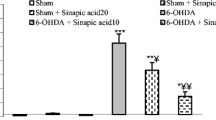Summary
Nigral cell death in Parkinson's disease (PD) may involve oxidative stress and mitochondrial dysfunction initiated by a decrease in reduced glutathione (GSH) levels in substantia nigra. L-buthionine-(S,R)-sulphoximine (BSO; 4.8 and 9.6 mg/kg/day), an irreversible inhibitor of γ-glutamyl cysteine synthetase, was chronically infused into the left lateral ventricle of rats over a period of 28 days and markedly reduced GSH concentrations in substantia nigra (approx. 59% and 65% in 4.8 and 9.6 mg/kg/d BSO respectively) and the striatum (approx. 63% and 80% in 4.8 and 9.6 mg/kg/d BSO respectively). However, the number of tyrosine hydroxylase (TH)-positive cells in substantia nigra was not altered by BSO-treatment compared to control animals. Similarly, there was no difference in specific [3H]-mazindol binding in the striatum and nucleus accumbens of BSO-treated rats compared to control rats. In conclusion, depletion of GSH following chronic administration of BSO in the rat brain does not cause damage to the nigrostriatal pathway and suggests that loss of GSH alone is not responsible for nigrostriatal damage in PD. Rather, GSH depletion may enhance the susceptibility of substantia nigra to destruction by endogenous or exogenous toxins.
Similar content being viewed by others

References
Dexter DT, Sian J, Jenner P, Marsden CD (1993) Implications of alterations in trace elements in Parkinson's disease and other neurological disorders affecting the basal ganglia. Adv Neurol 60: 273–281
Dexter DT, Sian J, Rose S, Hindmarsh JG, Mann VM, Cooper JM, Wells FR, Daniel SE, Lees AJ, Schapira AHV, Jenner P, Marsden CD (1994) Indices of oxidative stress and mitochondrial function in individuals with incidental Lewy body disease. Ann Neurol 35: 38–44
Gibb WRG, Lees AJ (1988) The relevence of Lewy body to the pathogenesis of idiopathic Parkinson's disease. J Neurol Neurosurg Psychiatry 51: 745–752
Griffith OW (1982) Mechanism of action, metabolism and toxicity of buthionine sulphoximine and its higher homologues, potent inhibitors of glutathione synthesis. J Biol Chem 257: 13704–13712
Griffith OW, Meister A (1985) Origin and turnover of mitochondrial glutathione. PNAS 82: 4668–4672
Jain A, Martensson J, Stole E, Auld PA, Meister A (1991) Glutathione deficiency leads to mitochondrial damage in brain. PNAS 88: 1913–1917
Javitch JA, Strittmatter SM, Snyder SH (1985) Differential visualisation of dopamine and norepinephrine uptake sites in rat brain using [3H]-mazindol autoradiography. J Neurosci 5: 1513–1521
Jellinger K (1987) The pathology of parkinsonism, 1st edn. Movement disorders 2. Butterworths, London, pp 125–130
Jenner P, Schapira AHV, Marsden CD (1992) New insights into the cause of Parkinson's disease. Neurology 42: 2241–2250
Mann VM, Cooper JM, Daniel SE, Srai K, Jenner P, Marsden CD, Schapira AHV (1994) Complex I, iron, and ferritin in Parkinson's disease substantia nigra. Ann Neurol 3: 876–881
Meister A (1991) Glutathione deficiency produced by inhibition of its synthesis and its reversal: applications in research and therapy. Pharmacol Ther 51: 155–194
Paxinos G, Watson C (1986) The rat brain in stereotaxic co-ordinates, 2nd edn. Academic Press, San Diego
Pellegrino LJ, Pellegrino AS, Cushman AJ (1979) Stereotaxic atlas of the rat brain, 2nd edn. Plenum Press, New York
Perry TL, Godin DV, Hansen S (1982) Parkinson's disease: a disorder due to nigral glutathione deficiency? Neurosci Lett 33: 305–310
Pileblad E, Magnusson T (1989) Intracerebrovetricular administration of L-buthionine sulfoximine: a method for depleting brain glutathione. J Neurochem 53: 1878–1882
Pileblad E, Magnusson T, Fornstedt B (1989) Reduction of brain glutathione by L-buthionine sulfoximine potentiates the dopamine-depleting action of 6-hydroxydopamine in rat striatum. J Neurochem 52: 978–980
Reed DJ, Babson JR, Beatty PW, Brodie AE, Ellis WW, Potter DW (1980) High performance liquid chromatography analysis of nanomole levels of glutathione, glutathione disulphide, and related thiols and disulphides. Anal Biochem 106: 55–62
Riederer P, Sofic E, Rausch W, Schmidt B, Reynolds GP, Jellinger K, Youdim MBH (1988) Transition metals, ferritin, glutathione and ascorbic acid in parkinsonian brains. J Neurochem 52: 515–520
Schapira AHV (1994) Evidence for mitochondrial dysfunction in Parkinson's disease: a critical appraisal. Mov Disord 9: 125–138
Seaton TA, Jenner P, Marsden CD (1996) Thioctic acid does not restore glutathione levels or protect against the potentiation of 6-hydroxydopamine toxicity induced by glutathione depletion in rat brain. J Neural Transm 103: 315–329
Sian J, Dexter DT, Lees AJ, Daniel S, Agid Y, Javoy-Agid F, Jenner P, Marsden CD (1994a) Alterations in glutathione levels in Parkinson's disease and other neurodegenerative disorders affecting basal ganglia. Ann Neurol 36: 348–355
Sian J, Dexter DT, Lees AJ, Daniel S, Jenner P, Marsden CD (1994b) Glutathionerelated enzymes in Parkinson's disease. Ann Neurol 36: 356–361
Sofic E, Paulus W, Jellinger P, Riederer P, Youdim MBH (1991) Selective increase of iron in substantia nigra zona compacta of parkinsonian brains. J Neurochem 56: 978–982
Wüllner U, Löschmann P-A, Eblen F, Klockgether (1995) Glutathione depletion potentiates MPP+ toxicity. J Neurol [Suppl 2] 242: 571
Wüllner U, Löschmann P-A, Schulz JB, Schmid A, Dringen R, Eblen F, Turksi L, Klockgether T (1996) Glutathione depletion potentiates MPTP and MPP+ toxicity in nigral dopaminergic neurones. NeuroReport 7: 921–923
Youdim MBH, Ben Schahar D, Riederer P (1989) Is Parkinson's disease a progressive siderosis of substantia nigra resulting in increased iron and melanin induced neurodegeneration? Acta Neurol Scand 126: 47–54
Zarow C, Chui HC (1991) A simple method for assessing neuronal number in the human substantia nigra. Soc Neurosci Abstr 17: 574.10
Author information
Authors and Affiliations
Rights and permissions
About this article
Cite this article
Toffa, S., Kunikowska, G.M., Zeng, B.Y. et al. Glutathione depletion in rat brain does not cause nigrostriatal pathway degeneration. J. Neural Transmission 104, 67–75 (1997). https://doi.org/10.1007/BF01271295
Received:
Accepted:
Issue Date:
DOI: https://doi.org/10.1007/BF01271295



